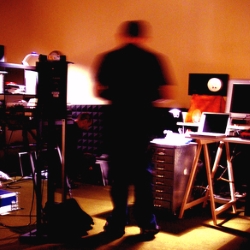Audio companies release a million new gadgets per week. For every piece of gear that one studio can’t live without, there’s another studio that’s never heard of it.
But there are certain things no one should ever start a session without – some of them items you’re unlikely to think about until you need them.
Here are seven critical pieces of the studio puzzle.
1. A Beautiful Pair Of Monitors
A DAW for your home studio can be a matter of taste. What interface works for you? How do you like your desktop to look while you’re mixing? Zeros are zeros and ones are ones, so there may not be distinguishable differences in recording quality from one application to another.
The same cannot be said for monitor speakers, however. Buying monitors for your studio is not the time to cheap out. Read reviews. If you can, visit them in someone else’s setup and listen. These speakers are the interface between the digital world and your ears, so unless you want to wear headphones until your face gets skinny, get yourself a decent pair.
2. Unopened Cables
How often do you hear a bad sound in the studio and discover that it’s just a bad cord? How about when you’re getting no sound from an expensive microphone? You start panicking and then realize it’s just the cable. Bad cables look fine, so they tend to get back into circulation with the good ones or thrown into a box of cables to resolder “when you get around to it.”
When there are more cables in the “fix-me” box than there are good working ones, you have a problem. Ninety percent of the time, it seems like those bad cables are the source of any studio issue. Have a couple unopened ones on hand (guitar cords and balanced mic cables) for these moments.
3. Compressed Air
If bad cords cause most of our problems, dirty pots (tone and volume knobs) seem to cause the rest. Almost everything we use, from guitars and basses to amps to effects pedals, has lots of these knobs. It’s not as though we keep them in clean settings all the time, either. All of our gear spends time in basements, garages, the trunks of cars, or places where people are holding drinks and crashing into one another. Pots get dusty and dirty. Blast them out with some canned air, improve your signal, and get back to work.
4. A Quiet Chair
Pick noises, breathing, or a musician shouting out because they’re having so much fun playing music. These are “good artifacts,” outside sounds that often end up on recordings because they add some realism and don’t distract.
Bad artifacts could include your neighbor’s barking dog, a cell phone alert beep, or the dreaded creaky chair. A drum throne that crackles or a squeaking swivel chair in your control room are two things that should be banished from your studio. Quiet chairs only, or these noises are sure to end up on somebody’s otherwise perfect take.
5. Incidental Percussion
Studio production often reveals “sneaky voids,” moments at which a song suddenly feels like it’s missing something. Even if you’ve been playing the song live and it sounds amazing, you might find that it needs something more in the studio.
Before you go hiring a session accordionist, try some incidental percussion: cowbell, wood blocks with sandpaper, even a soda can half-filled with dry rice. Extra percussion is cheap, easy to play, and the whole band can get into it. Sometimes this leads to a funky breakdown with the whole band jamming on percussion. Other times, it simply adds that one missing track to make a song whole. Either way, you should have a bin of percussion toys on hand.
6. Spare Microphone Clips
Do you know what breaks a lot in recording studios? The clips that hold microphones on mic stands. After all, they’re cheap and plastic, and people are always trying to force larger-diameter microphones into regular-sized clips. Some things don’t bend, they break. Trying to duct tape a microphone to a stand is not very professional and could very well affect your sound quality, so keep a spare clip or two around.
7. Food
When all the gear is working perfectly, everything’s in tune and the musicians are all in the groove, what could possibly make them stop? Hunger.
Recording is hungry and thirsty work, and musicians have a tendency to get up late and forget breakfast. The last thing you want is to have players and engineers drive off in three different directions to find their favorite burrito joints just when things are humming along. You’re losing critical time in the middle of your session. Once these folks leave, getting them all back in the room could take hours.
As a project leader or the one running the studio, it pays to get food ordered ahead of time or bring it to the session at the beginning. What’s more, feeding people spreads love and can only improve the vibe of the session, helping you make a recording that sounds and feels great.
Read and comment on the original article here.
Jesse Sterling Harrison is an author, recording artist, and part-time farmer. He lives in Massachusetts with his wife, three daughters, and a herd of ducks.





















